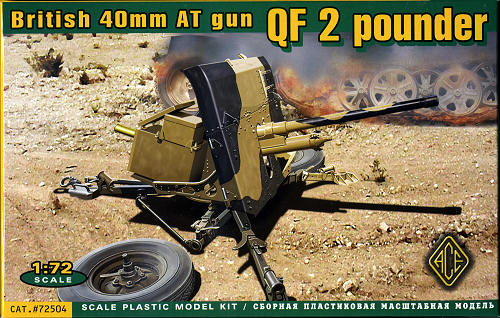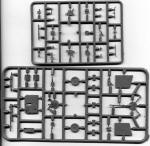
| KIT #: | 72504 |
| PRICE: | $ |
| DECALS: | None |
| REVIEWER: | Scott Van Aken |
| NOTES: |

| HISTORY |
The Ordnance QF 2-pounder (or simply "2 pounder gun") was a 40 mm (1.575 in) British anti-tank and vehicle-mounted gun, employed in the Second World War. It was actively used in the Battle of France, and during the North Africa campaign. As tanks became sufficiently armoured to stand up to its shots, it was gradually replaced by the 6-pounder, starting in 1942, though some remained in service until the end of the war. In its vehicle-mounted variant, the 2-pounder was also a common main gun on British tanks early in World War II, and was a typical main armament of armoured cars such as the Daimler throughout the war.
The gun first saw combat during the German invasion of the Low Countries, with the Belgian Army, and then with the British Army during the subsequent rear-guard actions at Dunkirk. Most of the British Army's 2-pdrs were left behind in France during the retreat, stripping most of the army's infantry anti-tank capability. Those guns captured at Dunkirk entered German service under the designation 4.0 cm Pak 192 (e) or4.0 cm Pak 154 (b), the "e" and "b" referring to England and Belgium respectively.
Although the Woolwich Arsenal had already designed a successor to the 2-pdr, the 6 pounder gun, it was decided in the face of a likely German invasion to re-equip the army with the 2-pdr, avoiding the period of adaptation to production, and also of re-training and acclimatization with the new weapon. This had the effect of delaying production of the 6 pounder until November 1941, and it was only in spring 1942 when the new gun reached frontline units. As such, for most of the North African campaign, the army still had to rely on the 2-pdr, aided by the 25 pounder gun-howitzer functioning as an anti-tank gun - a role for which it was capable though at the expense of taking it away from its main artillery role. The evolution of German tank design meant anti-armour performance of the 2-pdr gradually became insufficient, however the gun owes large part of the bad reputation it gained during the campaign to the open terrain (which made the high-silhouette piece hard to conceal) and to less than perfect tactics.
Further, in North Africa it was found that towing the 2-pdr long distances across rough, stony deserts damaged the weapon. Starting in 1941, the British developed the "en portee" method of mounting the 2-pdr (and later its successor, the 6 pounder) on a truck. Though only intended as a carrying method, with the gun being unloaded for firing, crews tended to fire their weapons from their vehicles for more mobility, with consequent casualties. Hence the vehicles tended to reverse into action so that the gunshield of the 2-pdr would provide a measure of protection against enemy fire.
From mid-1942, the 2-pdr was increasingly displaced to infantry anti-tank platoons, to the Home Guard units in Great Britain and to the Far East, where it was still effective against the smaller and more lightly armored Japanese tanks. It was finally removed from service entirely in December 1945. As a vehicle weapon, it remained in use throughout the war. Although most tanks models equipped with it were withdrawn or upgraded to the 6-pdr, it remained in use with armoured cars.
Its performance as an anti-armour weapon was improved later in the war with the development of more sophisticated ammunition and got an additional boost with the introduction of the Littlejohn adaptor, which converted it to squeeze-bore design firing specially-designed shells at much higher velocities. (However, the Littlejohn adaptor also prevented the use of High Explosive rounds.) These improvements, however, were constantly outpaced by improvements in tank design.
The guns were never equipped with High Explosive rounds which would have given the gun some capability against un-armoured targets, although the rounds had been produced. The shells were not introduced, however, because it was felt that the tiny amount of explosive contained in such a relatively small shell would be ineffective. This proved to be a problem in combat when duels would break out between opposing anti-tank gun units. It also presented a major problem for armoured vehicles equipped with the gun, which were equally limited in dealing with opposing anti-tank guns (and their crews) at distances beyond the range of their machine gun.
| THE KIT |
 As you can imagine, this is a relatively small kit, but with quite a few parts. The molding of the kit is fairly good with some of the thicker pieces suffering from sunken areas that will need to be filled. The parts themselves are a bit on the 'soft' side when it comes to detailing, something that is quite common with low pressure molding. This also can provide somewhat large mold seams so be prepared to clean up all of the parts prior to use.
As you can imagine, this is a relatively small kit, but with quite a few parts. The molding of the kit is fairly good with some of the thicker pieces suffering from sunken areas that will need to be filled. The parts themselves are a bit on the 'soft' side when it comes to detailing, something that is quite common with low pressure molding. This also can provide somewhat large mold seams so be prepared to clean up all of the parts prior to use.
There are basically two major assemblies with this kit. One is the gun itself. The gun is not designed to be be elevated. It comes with all the appropriate elevation and azimuth wheels as well as what looks like a large ammo box and a gunner's seat. The other half of the gun is the mount. This can be built in two ways. One is for transport with the wheels attached and the legs folded up. The other is for use with the wheels detached and the bracing legs spread out. The gun includes a forward shield as well as two optional side shields.
Ace's instructions are well drawn and show precisely where the various parts fit. I highly recommend test fitting each part prior to cementing. There are no decals, but the markings options are for two guns. One in North Africa during 1941 with a Light Stone and Very Dark Brown camouflage pattern. The other is for France in 1940 painted in Middle Bronze Green #23 and Deep Bronze Green #24. I am not sure just where to find these colors as no paint manufacturer information is provided.
| CONCLUSIONS |
I have built Ace kits in the past and with some careful building, it will make a very nice small scale gun model. The perfect piece for either a diorama or to add to an anti-tank gun collection.
| REFERENCES |
May 2012
Thanks to www.scale-model-kits.com for the preview kit. Visit the link to get yours. If you would like your product reviewed fairly and fairly quickly, please contactme or see other details in the Note toContributors.